Week 4 Applying the Legal Framework to Other Specific Issues in Counter-Terrorism
Practice e.g. ‘targeted’ killings, surveillance and sanctions
In this class, we consider the application of IHRL (and to the extent applicable, IHL) in
relation to specific laws and practices arising in the counter-terrorism context. What are
the range of issues and controversies that arise, in theory and in practice, and what are
the implications for effective counter-terrorism, for protection of persons and/or the
rule of law? Among the examples to explore are the lawfulness of the use of force and
targeted killings, surveillance, responses to foreign terrorist fighters and the impact on
equality. How can states meet the challenges and obligations of countering terrorism
while respecting human rights?
In the second part of the class, we will consider the role and implications of terror-
related sanctions, and hear from the former UN Ombudsperson on Al Qaeda sanctions,
Kim Prost.
Required Reading: Life
War on Terror Chapter 7A – pages 500-506
Life: arbitrary deprivation, lethal use of force and the death penalty
Right to life is a non-derogable right, even in conflict, and the prohibition of extra-
judicial executions is prohibited in customary law, and has become a jus cogens norm.
Positive obligations of the state:
- Duty to take measures to protect from terrorist attacks
- Duty to protect life in responding to terrorism (HRC General Comment No. 6)
State may be responsible not only for unlawful killing by its own agents, but also by
private parties where it failed to take effective action to prevent the deaths.
Also duty of the state to protect the right to life in action taken against suspected
‘terrorists’ – this may be an issue in enforcement operations that result in the lethal use
of force, in hostage-taking situations, or through practices of targeted killings.
In context of armed conflict, IHL applies alongside IHRL – what constitutes ‘arbitrary
deprivation of life’ must be interpreted in light of all applicable law, including IHL.
Where IHL permits the killing of a legitimate military target, the deprivation of life has a
legal basis and is not arbitrary. In the context of hostilities, human rights courts have
also accepted that the killing of civilians by aerial bombardment, which was incidental
and proportionate to lawful military operation, could be considered justifiable.
However, killings of persons in armed conflict in circumstances where there is no IHL
justification would amount to arbitrary deprivations of the right to life.
,Outside of armed conflict, lethal use of force by a state is governed by IHRL and is
strictly curtailed:
- It must be absolutely necessary to achieve a legitimate aim e.g. protecting life or
effecting a lawful arrest or detention – this encompasses a proportionality test.
- E.g. Article 2(2) EHCR notes that where employed in defence against unlawful
violence, to effect lawful arrest or detention or quell a riot or insurrection, lethal
force will not constitute an unlawful deprivation of life, provided that the action
taken is no more than ‘absolutely necessary’.
- So use of lethal force must be a matter of last resort and all non-lethal measures
must have been exhausted.
The use of lethal force that may prove necessary in the course of a lawful law
enforcement operation, or to protect in a hostage-taking situation, must be
distinguished from operations that have the specific targeting and killing of an
individual as their objective
- UN Special Rapporteur on Extrajudicial, Summary, or Arbitrary Executions has
defined the policy of ‘targeted pre-emptive killings’ of suspected terrorists as a
‘grave human rights violation’.
- Critical aspect of necessity test an operation must be planned as well as
carried out in a manner that strictly limits the danger of recourse to the use of
force.
- ECtHR has noted that if lethal force is used absent ‘all feasible precautions in the
choice of means and methods of a security operation mounted against an
opposing group with a view to avoiding and, in any event, minimising incidental
loss of civil life’, it will be deemed unnecessary and amount to arbitrary
deprivation of life – Ergi v Turkey.
- So generally, there should be an opportunity to surrender, unless doing so would
present an imminent danger to life.
- Where death does result from the lethal use of force, the obligation arises to
ensure that ‘a thorough, effective and independent investigation is automatically
carried out’.
Another issue application of the death penalty to terrorism-related crimes
- Death penalty is not per se prohibited by international law, but particular
instruments abolish or restrict the application of the penalty e.g. Protocol No. 6 +
No. 13 to the ECHR, Second Optional Protocol to the ICCPR and the Protocol to
the American Convention on Human Rights to Abolish the Death Penalty impose
an obligation on states parties to abolish the death penalty.
- Imposition of capital punishment following judicial processes that do not have
the highest standards of justice = would amount to arbitrary deprivation of life.
This is backed up by the Council of Europe, where states cannot transfer suspects
where there is a risk of the death penalty being imposed.
,War on Terror Chapter 6A – pages 363-375
Targeting: the principle of distinction and proportionality
This principle requires that civilians and civilian objects must be distinguished from
military targets, and operations directed only against the latter. This is a principle of
customary law that is applicable to all types of armed conflict.
Attacks are unlawful if they are:
- Directed specifically against civilians or civilian objects
- Launched indiscriminately without distinction between civilians and military
targets; or
- Directed at military objectives, but anticipated to cause damage to civilians or
civilian objects that is disproportionate to the military advantage anticipated at
the time of launching the attack – Article 51(2) and (4) API and Article 13 APII.
- Only objects that contribute to the adversary’s military capability, which, if
destroyed, would give rise to military advantage, can be attacked.
Lethal use of force against combatants and armed groups
In IAC = members of armed forces of adversary are most obvious legitimate military
targets.
‘Combatants’ include regular troops, but also irregular groups that fight alongside
them and are ‘under a command responsible to that party for the conduct of its
subordinates’. Members of an armed group that ‘belongs’ to a party to the conflict may
also be considered de facto combatants and be susceptible to attack.
- Lethal targeting of those who fight with the adversary’s forces, which may
amount to murder if there is no armed conflict, is generally lawful in time of
conflict under IHL.
- Combatant in IAC can be legitimately targeted at all times during the conflict,
even if off-duty at time of attack.
- As soon as combatants are hors de combat, voluntarily or involuntarily e.g.
through illness, injury, surrender or capture, they are no longer military
objectives but become entitled to protection = unlawful to kill a person who has
been wounded, has surrendered or been captured, or is otherwise no longer
participating in the conflict.
- Combatants among the civilian population do not deprive the entire population
of its civilian character.
In NIACs question of lawful targeting is more controversial, because treaty law
governing NIACs does not provide a definition of persons who may be subject to attack.
But commentators suggest that absent an explicit provision of IHL, rules comparable to
, those applicable in IAC can be read into the law of NIAC = organised armed groups
would be treated as legitimate targets on same basis as combatants in IAC.
- Either way, it is well recognised that they lose their protection from attack if they
directly participate in hostilities.
Civilian protection and ‘direct and active participation in hostilities’
Civilians must not be the object of attack this would mean that attacks are
‘indiscriminate’ or ‘disproportionate’. There is no exception to this prohibition.
Civilian immunity from attack is lost only where the person takes an active and direct
part in hostilities, as set down in IHL treaties and customary law.
Targeted Killings decision (Public Committee v Torture v government of Israel HCJ, Dec
(2006) This is reflected, for example, in a decision by the Israeli Supreme Court,
which found that the situation in the West Bank and the Gaza Strip amounted to an IAC
in which terrorist groups participated as civilians who had lost their immunity from
attack: ‘terrorists participating in hostilities do not cease to be civilians but by their acts
they deny themselves the aspect of their civilian status which grants them protection
from military attack’.121 Thus, according to the Israeli Supreme Court, terrorists may
be targeted for military purposes where they actively and directly participate in
hostilities.
- ‘Direct participation in hostilities’ (DPH) covers ‘acts of war which by their
nature or purpose are likely to cause actual harm to the personnel and
equipment of the enemy armed forces’ – ICRC Commentary.
- An ‘act of war’ covers fighting against opposing armed forces, but does not cover
affiliation with the adversary.
- ICRC DPH Guidance DPH stands for ‘specific acts carried out by individuals as
part of the conduct of hostilities between parties to an armed conflict’.
- E.g. Israeli Supreme Court found that selling food, providing strategic analysis
and logistical general support, including monetary aid, were taking an indirect
part in hostilities and so would not meet the DPH criteria.
- Rule that if any doubt arises as to whether someone is a combatant or a civilians,
he or she must be presumed a civilian – Article 50 API.
- Where a civilian does DPH, he or she loses protected status only ‘for such time’ as
his or her participation continues. A civilian who participates on an ad hoc basis
can only be targeted while actually engaging in the hostile acts themselves.
- However, the fact that a civilian directly participating in hostilities may have lost
immunity from attack does not mean that the lethal use of force against that
person will always be justified:
o ICRC DPH Guidance where the circumstances are such that the armed/
police forces of the government may be able to capture an individual





